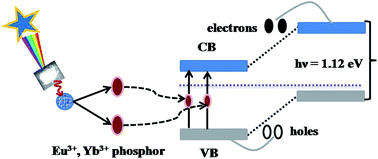Down shifting and quantum cutting from Eu3+, Yb3+ co-doped Ca12Al14O33 phosphor: a dual mode emitting material
Abstract
We report the quantum cutting (QC) in a Eu3+, Yb3+ co-doped Ca12Al14O33 phosphor synthesized through combustion method. The X-ray diffraction (XRD), transmission electron microscopy (TEM) and scanning electron microscopy (SEM) measurements reveal the crystalline nature of the phosphor sample. The photoluminescence (PL) spectra of the different samples have been studied using 266 and 394 nm radiation, which give an intense red emission at 612 nm due to 5D0 → 7F2 transition. The addition of Yb3+ in the Eu3+ doped sample reduces the emission intensity of Eu3+ bands in the visible region continuously whereas in the NIR region, the intensity of the Yb3+ band first increases up to 2 mol% and then decreases. This is due to cooperative downconversion energy transfer from Eu3+ to Yb3+ ions and concentration quenching. The decay curve analyses of different samples reveal an efficient energy transfer from Eu3+ to Yb3+ ions. The quantum efficiency (QE) has been calculated for different concentrations of Yb3+ ions and is estimated to be 197%. The possible mechanisms involved in different transitions and energy transfer processes can be understood using a schematic energy level diagram. The phosphor sample is a potential candidate for enhancing the efficiency of c-Si solar cells.

- This article is part of the themed collection: Editors Collection for RSC Advances - India

 Please wait while we load your content...
Please wait while we load your content...